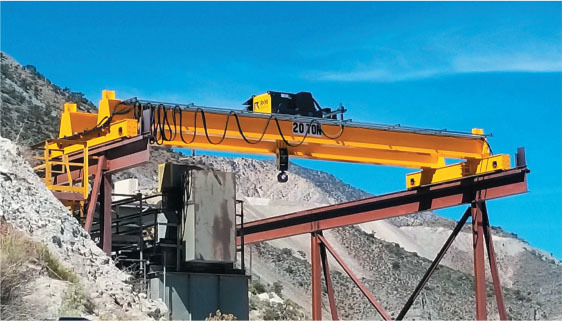Solutions Spotlight
 Members of the Crane Manufacturers Association of America Inc.—CMAA—are at the forefront of the crane industry.
Members of the Crane Manufacturers Association of America Inc.—CMAA—are at the forefront of the crane industry.
“We’ve been around for a long time—we were founded in 1927 as the Electric Overhead Crane Institute to promote the standardization of cranes as well as uniform quality and performance,” said Dan Beilfuss, CMAA’s president and general manager of MHI member Magnetek by Columbus McKinnon Corp.
In 1955, the association was incorporated as the Crane Manufacturers Association of America, Inc., and is now an independent trade association affiliated with MHI. Member companies representing the industry leaders in the overhead crane industry serve the United States market from operations based in the U.S., Canada and Mexico.
“The goal of CMAA is to be known as the premier guide for overhead cranes,” said Molly Wood, CMAA’s vice president and engineering manager for MHI member Ace Industries.
“We meet twice a year to write specifications, and we work on improving the standards—whether it be safety or design, without impeding on the ingenuity of crane companies,” Wood said.
Engineering specifications are widely recognized as the preferred design standard for overhead traveling cranes, integrated crane systems and crane components. Design specifications roll out every five years, with the next to roll out in 2025. Current and future specifications include:
CMAA Spec 70—Multiple Girder Cranes, and CMAA Spec 74—Single Girder Cranes. These two specifications promote standardization and provide a basis for uniform quality and performance of overhead cranes. They contain information that can be helpful for purchasers and users of cranes, as well as engineers and architects. These specs consist of seven sections: general specifications, crane service classifications, structural design, mechanical design, electrical equipment, crane inquiry data sheet and glossary.
CMAA Spec 78—Professional Services. Specification 78 has been purposely developed by CMAA to recognize overhead traveling crane service and the service of associated hoisting equipment as an industry worthy of having guidelines and standards for providing high-quality, professional services performed by safety-minded, manufacturer-trained and certified technicians. With the introduction of Specification 78, CMAA intends to set higher performance standards and raise customer expectations related to the service of overhead traveling cranes and associated hoisting equipment.
CMAA Spec 79—Crane Operators Manual. This 32-page manual has been prepared by the Engineering Committee of CMAA. Operation of an overhead or gantry crane involves more than operating the controls of the crane. The operator must consider and anticipate the motions and actions that will occur as a result of operating the controls. Specification 79 also lists qualifications required to be a crane operator, as well as “shall and shall nots” for operators.
“We try to make the crane operators manual very affordable so companies can hand them out to all of their employees,” Wood said.
CMAA Spec 80—Below-The-Hook Lifting Device Operator’s Manual. The document is recommended for use as a complement to CMAA Specification 79—Crane Operator’s Manual, as well as in conjunction with the operating instructions and maintenance manuals provided by the equipment manufacturer(s).
The new specification’s contents include definitions of safety alert symbols and placards, including those indicating “danger,” “warning,” “caution” and “notice.” It also offers illustrations of the most commonly used below-the-hook lifting devices, which are specially designed to be the interface between a specific type of load and the hoist and overhead crane that will lift and transport it.
CMAA Spec 76—Jib Cranes. This is a brand new specification that is currently in process. CMAA is targeting 2024 for completion.
“The purpose of upgrading these standards is to make sure we follow the trends in the technology that is used, designing with safety factors in mind,” said Sylvain Raymond, CTO of the North America division of MHI member REEL COH Inc.
“Whenever companies buy a crane and associated equipment from a manufacturer, they should make sure that it is built according to CMAA’s standards so they know they’re getting safe equipment of high quality,” Raymond said.
 MHI Solutions Improving Supply Chain Performance
MHI Solutions Improving Supply Chain Performance